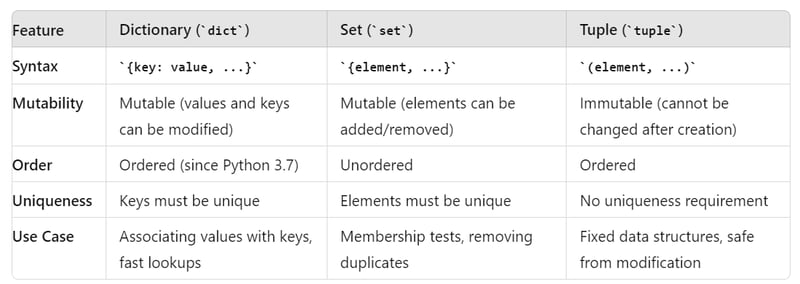Python - 辞書、セット、タプル
これら 3 つはすべて、Python の異なるタイプのデータ構造です。これは、さまざまなデータ コレクションを保存するために使用されます。要件のユースケースに基づいて、これらの中から選択する必要があります。

辞書 (dict):
- ディクショナリはキーと値のペアのコレクションであり、各キーは値に関連付けられています
- キーは一意である必要があるため、キー値に基づいてデータを取得できます(キーベースの検索)。
- 3.7 までは辞書に順序はありませんが、値は変更できます。キー名を直接変更することはできません
構文:
在庫 = {'リンゴ':20, 'バナナ':30 , 'ニンジン':15, 'ミルク':15}
print('\t1.在庫アイテム', 在庫)
以下の構文を使用して、辞書に別の値を追加したり、既存のキーの値を変更したりできます
在庫['卵'] = 20
在庫['パン'] = 25
print('\t2.更新された在庫アイテム', 在庫)
在庫['卵']= 在庫['卵'] 5
print('\t3.再入荷後',在庫)
- dict からのデータの削除は、del キーワードを使用して実行できます。
- inキーワードを使用してデータの存在を確認できます。結果はブール値になります。
在庫を削除['キャロット']
在庫削除['パン']
print('\t4.削除後に更新されたインベントリ', inventory)
is_bananas_in_inventory = 在庫に「バナナ」があります
print('\t5a. バナナは在庫にあります', is_bananas_in_inventory)
is_oranges_in_inventory = 在庫内の「オレンジ」
print('\t5b. オレンジは在庫にあります', is_oranges_in_inventory)
メモ:
さらに、dict.items() は、辞書内の各項目をタプル (キーと値のペアのような) として与えます。 list(dict.items()) を使用すると、データをリストとして取得することもできます。 for ループと if 条件を使用すると、特定のキーにアクセスし、そのデータに対して目的の操作を実行できます
for product, product_count in inventory.items():
print('\t\t6. Product:', product, 'count is:', product_count)
print ('\t7. Iterating inventory gives tuple:', inventory.items())
#Printing only egg count(Value of key 'egg') by itearting dict
for product, product_count in inventory.items():
if product is 'egg':
print('\t8. Product:', product, ' its count is:', product_count)
#Printing egg count (value of key 'egg')
print('\t9. Count of apple',inventory['egg'])
Output:
1. Inventory items {'apple': 20, 'Banana': 30, 'carrot': 15, 'milk': 15}
2. Updated Inventory items {'apple': 20, 'Banana': 30, 'carrot': 15, 'milk': 15, 'egg': 20, 'bread': 25}
3. After restocking {'apple': 30, 'Banana': 30, 'carrot': 15, 'milk': 15, 'egg': 25, 'bread': 25}
4. Updated Inventory after delete {'apple': 30, 'Banana': 30, 'milk': 15, 'egg': 25}
5a. Is banana in inventory True
5b. Is Orange in inventory False
6. Product: apple count is: 30
6. Product: Banana count is: 30
6. Product: milk count is: 15
6. Product: egg count is: 25
7. Iterating inventory gives tuple: dict_items([('apple', 30), ('Banana', 30), ('milk', 15), ('egg', 25)])
8. Product: egg its count is: 25
9. Count of apple 25
セット:
セットは、順序付けされていない一意の要素のコレクションです。セットは変更可能ですが、要素の重複は許可されません。
構文:
botanical_garden = {'バラ', '蓮', 'ユリ'}
botanical_garden.add('ジャスミン')
botanical_garden.remove('ローズ')
is_present_Jasmine = 植物園の「ジャスミン」
上記では、セットを定義し、値を追加して削除することがわかりました。同じ要素をセットに追加すると、エラーが発生します。
ベン図と同様に 2 つのセットを比較することもできます。 2 つのデータセットの和集合、差分、積集合など。
botanical_garden = {'Tuple', 'rose', 'Lily', 'Jasmine', 'lotus'}
rose_garden = {'rose', 'lotus', 'Hybiscus'}
common_flower= botanical_garden.intersection(rose_garden)
flowers_only_in_bg = botanical_garden.difference(rose_garden)
flowers_in_both_set = botanical_garden.union(rose_garden)
Output will be a set by default.
If needed we can typecase into list using list(expression)
タプル:
タプルは、要素の順序付けされたコレクションであり、不変です。つまり、作成後に変更することはできません。
構文:
ooty_trip = ('Ooty', '2024-1-1', 'Botanical_Garden')
munnar_trip = ('Munar', '2024-06-06', 'Eravikulam National Park')
germany_trip = ('Germany', '2025-1-1', 'Lueneburg')
print('\t1. Trip details', ooty_trip, germany_trip)
#Accessing tuple using index
location = ooty_trip[0]
date = ooty_trip[1]
place = ooty_trip[2]
print(f'\t2a. Location: {location} Date: {date} Place: {place} ')
location, date, place =germany_trip # Assinging a tuple to 3 different variables
print(f'\t2b. Location: {location} Date: {date} Place: {place} ')
print('\t3. The count of ooty_trip is ',ooty_trip.count)
Output:
1. Trip details ('Ooty', '2024-1-1', 'Botanical_Garden') ('Germany', '2025-1-1', 'Lueneburg')
2a. Location: Ooty Date: 2024-1-1 Place: Botanical_Garden
2b. Location: Germany Date: 2025-1-1 Place: Lueneburg
3. The count of ooty_trip is
タプルにはインデックスを使用してアクセスできます。タプルの値は複数の変数に簡単に割り当てることができます。 2 つのタプルを結合して、別のタプルを作成できます。ただし、タプルは変更できません。
-
 MySQLデータベースメソッドは、同じインスタンスをダンプする必要はありません同じインスタンスでmysqlデータベースをコピーする 同じmysqlインスタンスでデータベースをコピーすることはできません。以下の方法は、従来のダンプアンドインポートプロセスのより簡単な代替手段を提供します。 | mysql new_db_name このコマンドは、new_db_nam...プログラミング 2025-07-17に投稿されました
MySQLデータベースメソッドは、同じインスタンスをダンプする必要はありません同じインスタンスでmysqlデータベースをコピーする 同じmysqlインスタンスでデータベースをコピーすることはできません。以下の方法は、従来のダンプアンドインポートプロセスのより簡単な代替手段を提供します。 | mysql new_db_name このコマンドは、new_db_nam...プログラミング 2025-07-17に投稿されました -
 PHPの2つの等しいサイズの配列から値を同期して反復して印刷するにはどうすればよいですか?同じサイズの2つの配列の2つの配列から値を同期して反復して印刷する場合、同サイズの2つの配列を使用してselectboxを作成する場合、1つは対応する名前を含む1つを使用して、困難が不適切なsyntaxに起因する可能性があります。アレイ: foreach($ codes as $ code、...プログラミング 2025-07-17に投稿されました
PHPの2つの等しいサイズの配列から値を同期して反復して印刷するにはどうすればよいですか?同じサイズの2つの配列の2つの配列から値を同期して反復して印刷する場合、同サイズの2つの配列を使用してselectboxを作成する場合、1つは対応する名前を含む1つを使用して、困難が不適切なsyntaxに起因する可能性があります。アレイ: foreach($ codes as $ code、...プログラミング 2025-07-17に投稿されました -
 Firefoxバックボタンを使用すると、JavaScriptの実行が停止するのはなぜですか?navigational Historyの問題:JavaScriptは、Firefoxバックボタンを使用した後に実行を停止します ユーザーは、JavaScriptスクリプトが以前の訪問ページを介して回復したときに実行されない問題に遭遇する可能性があります。この問題は、ChromeやInt...プログラミング 2025-07-17に投稿されました
Firefoxバックボタンを使用すると、JavaScriptの実行が停止するのはなぜですか?navigational Historyの問題:JavaScriptは、Firefoxバックボタンを使用した後に実行を停止します ユーザーは、JavaScriptスクリプトが以前の訪問ページを介して回復したときに実行されない問題に遭遇する可能性があります。この問題は、ChromeやInt...プログラミング 2025-07-17に投稿されました -
 フォームリフレッシュ後に重複した提出を防ぐ方法は?を更新することで重複した提出を防ぐ Web開発で、フォームの提出後にページが更新された場合に重複した提出の問題に遭遇することが一般的です。これに対処するには、次のアプローチを検討してください。 if(isset($ _ post ['name'])){ ...プログラミング 2025-07-17に投稿されました
フォームリフレッシュ後に重複した提出を防ぐ方法は?を更新することで重複した提出を防ぐ Web開発で、フォームの提出後にページが更新された場合に重複した提出の問題に遭遇することが一般的です。これに対処するには、次のアプローチを検討してください。 if(isset($ _ post ['name'])){ ...プログラミング 2025-07-17に投稿されました -
 名前空間コロンを使用したPHP SimplexML解析XMLメソッドXMLをphp simplexmlは、XMLをコロンと比較するXMLを接続するXMLを接続した場合、XML要素を含むXMLを解析するときに困難に遭遇します。この問題は、simplexmlがデフォルトの名前空間から逸脱するXML構造を処理できないために発生します。例: $ xml ...プログラミング 2025-07-17に投稿されました
名前空間コロンを使用したPHP SimplexML解析XMLメソッドXMLをphp simplexmlは、XMLをコロンと比較するXMLを接続するXMLを接続した場合、XML要素を含むXMLを解析するときに困難に遭遇します。この問題は、simplexmlがデフォルトの名前空間から逸脱するXML構造を処理できないために発生します。例: $ xml ...プログラミング 2025-07-17に投稿されました -
 Python Metaclass作業原則とクラスの作成とカスタマイズPythonのメタクラスとは?クラスがインスタンスを作成するのと同じように、Metaclassはクラスを作成します。クラスの作成プロセスを制御する層を提供し、クラスの動作と属性のカスタマイズを可能にします。これは、クラス自体がクラスキーワードを使用してクラスの「説明」から作成されたインスタン...プログラミング 2025-07-17に投稿されました
Python Metaclass作業原則とクラスの作成とカスタマイズPythonのメタクラスとは?クラスがインスタンスを作成するのと同じように、Metaclassはクラスを作成します。クラスの作成プロセスを制御する層を提供し、クラスの動作と属性のカスタマイズを可能にします。これは、クラス自体がクラスキーワードを使用してクラスの「説明」から作成されたインスタン...プログラミング 2025-07-17に投稿されました -
 バージョン5.6.5の前にMySQLのタイムスタンプ列を使用してcurrent_timestampを使用することの制限は何でしたか?の制限current_timestampがデフォルトまたは5.6.5より前のmysqlバージョンのcurrent_timestampの更新条項の制限 は歴史的に、5.6.5以前のmysqlバージョンでは、デフォルトの列のみを制限しました。 current_timestamp句。この制限は、20...プログラミング 2025-07-17に投稿されました
バージョン5.6.5の前にMySQLのタイムスタンプ列を使用してcurrent_timestampを使用することの制限は何でしたか?の制限current_timestampがデフォルトまたは5.6.5より前のmysqlバージョンのcurrent_timestampの更新条項の制限 は歴史的に、5.6.5以前のmysqlバージョンでは、デフォルトの列のみを制限しました。 current_timestamp句。この制限は、20...プログラミング 2025-07-17に投稿されました -
 Javaアレイで要素位置を見つけるためのヒントJavaアレイの の要素位置を取得するJavaのアレイクラス内で、アレイ内の特定の要素の位置を決定する直接的な「インデックス」方法はありません。ただし、アレイユーティリティクラスは、この機能を達成するための代替方法を提供します。コード: java.util.arrays.aslist...プログラミング 2025-07-17に投稿されました
Javaアレイで要素位置を見つけるためのヒントJavaアレイの の要素位置を取得するJavaのアレイクラス内で、アレイ内の特定の要素の位置を決定する直接的な「インデックス」方法はありません。ただし、アレイユーティリティクラスは、この機能を達成するための代替方法を提供します。コード: java.util.arrays.aslist...プログラミング 2025-07-17に投稿されました -
 なぜ画像はまだChromeに境界があるのですか? `border:none;`無効な解決策cromeの画像境界を削除する 1つの頻繁な問題は、chromeとie9の画像を操作する際に遭遇する頻繁な問題です。と「国境:なし;」 CSSで。この問題を解決するには、次のアプローチを検討してください。スタイル。これを回避するには、次のCSS IDブロックを使用して、目的のパディング...プログラミング 2025-07-17に投稿されました
なぜ画像はまだChromeに境界があるのですか? `border:none;`無効な解決策cromeの画像境界を削除する 1つの頻繁な問題は、chromeとie9の画像を操作する際に遭遇する頻繁な問題です。と「国境:なし;」 CSSで。この問題を解決するには、次のアプローチを検討してください。スタイル。これを回避するには、次のCSS IDブロックを使用して、目的のパディング...プログラミング 2025-07-17に投稿されました -
 FASTAPIカスタム404ページ作成ガイドcustom 404 Fastapi を備えたPage not inound Page not foundページを作成するには、Fastapiがいくつかのアプローチを提供します。適切な方法は、特定の要件に依存します。 call_next(リクエスト) response.status_c...プログラミング 2025-07-17に投稿されました
FASTAPIカスタム404ページ作成ガイドcustom 404 Fastapi を備えたPage not inound Page not foundページを作成するには、Fastapiがいくつかのアプローチを提供します。適切な方法は、特定の要件に依存します。 call_next(リクエスト) response.status_c...プログラミング 2025-07-17に投稿されました -
 偽のウェイクアップは本当にJavaで起こりますか?Javaの偽りの目覚め:現実か神話ですか?そのような動作の可能性は存在しますが、問題は残ります:それらは実際に実際に発生しますか?プロセスが信号を受信すると、EINTRで突然戻ってきて、ブロッキングシステムの呼び出しを早期に終了させる可能性があります。その結果、POSIX信号はスプリアスウェ...プログラミング 2025-07-17に投稿されました
偽のウェイクアップは本当にJavaで起こりますか?Javaの偽りの目覚め:現実か神話ですか?そのような動作の可能性は存在しますが、問題は残ります:それらは実際に実際に発生しますか?プロセスが信号を受信すると、EINTRで突然戻ってきて、ブロッキングシステムの呼び出しを早期に終了させる可能性があります。その結果、POSIX信号はスプリアスウェ...プログラミング 2025-07-17に投稿されました -
 UTF8 MySQLテーブルでLATIN1文字をUTF8に正しく変換する方法latin1文字をUTF8テーブル内のutf8に変換する diaCriticsのキャラクターが遭遇した問題に遭遇しました( "Jáuòiñe")がUTF8テーブルで存在していないために、utf8テーブルが不足しているために存在していませんでした。 「mysql_se...プログラミング 2025-07-17に投稿されました
UTF8 MySQLテーブルでLATIN1文字をUTF8に正しく変換する方法latin1文字をUTF8テーブル内のutf8に変換する diaCriticsのキャラクターが遭遇した問題に遭遇しました( "Jáuòiñe")がUTF8テーブルで存在していないために、utf8テーブルが不足しているために存在していませんでした。 「mysql_se...プログラミング 2025-07-17に投稿されました -
 PostgreSQLの各一意の識別子の最後の行を効率的に取得するにはどうすればよいですか?postgresql:各一意の識別子の最後の行 を抽出します。次のデータを検討してください: select distinct on (id) id, date, another_info from the_table order by id, date desc; データセット内の一...プログラミング 2025-07-17に投稿されました
PostgreSQLの各一意の識別子の最後の行を効率的に取得するにはどうすればよいですか?postgresql:各一意の識別子の最後の行 を抽出します。次のデータを検討してください: select distinct on (id) id, date, another_info from the_table order by id, date desc; データセット内の一...プログラミング 2025-07-17に投稿されました -
 なぜPHPのDateTime :: Modify( '+1 Month')が予期しない結果を生み出すのですか?PHP DateTimeで月数の変更:PHPのDateTimeクラスを操作する場合、数か月を追加または減算する場合、意図した動作を発見します。ドキュメントが警告しているように、これらの操作は見た目ほど直感的ではないため、これらの操作に「注意してください」。 $ date-> modify(...プログラミング 2025-07-17に投稿されました
なぜPHPのDateTime :: Modify( '+1 Month')が予期しない結果を生み出すのですか?PHP DateTimeで月数の変更:PHPのDateTimeクラスを操作する場合、数か月を追加または減算する場合、意図した動作を発見します。ドキュメントが警告しているように、これらの操作は見た目ほど直感的ではないため、これらの操作に「注意してください」。 $ date-> modify(...プログラミング 2025-07-17に投稿されました -
 GO言語ガベージコレクションでスライスメモリを処理する方法は?Go slices:aftertial analysis *q =(*q)[1:len(*q)] rを返します } FUNCプッシュバック(Q *[]文字列、文字列){ *q = append(*q、a) } この場合、要素が正面からポップされると、スライスが...プログラミング 2025-07-17に投稿されました
GO言語ガベージコレクションでスライスメモリを処理する方法は?Go slices:aftertial analysis *q =(*q)[1:len(*q)] rを返します } FUNCプッシュバック(Q *[]文字列、文字列){ *q = append(*q、a) } この場合、要素が正面からポップされると、スライスが...プログラミング 2025-07-17に投稿されました
中国語を勉強する
- 1 「歩く」は中国語で何と言いますか? 走路 中国語の発音、走路 中国語学習
- 2 「飛行機に乗る」は中国語で何と言いますか? 坐飞机 中国語の発音、坐飞机 中国語学習
- 3 「電車に乗る」は中国語で何と言いますか? 坐火车 中国語の発音、坐火车 中国語学習
- 4 「バスに乗る」は中国語で何と言いますか? 坐车 中国語の発音、坐车 中国語学習
- 5 中国語でドライブは何と言うでしょう? 开车 中国語の発音、开车 中国語学習
- 6 水泳は中国語で何と言うでしょう? 游泳 中国語の発音、游泳 中国語学習
- 7 中国語で自転車に乗るってなんて言うの? 骑自行车 中国語の発音、骑自行车 中国語学習
- 8 中国語で挨拶はなんて言うの? 你好中国語の発音、你好中国語学習
- 9 中国語でありがとうってなんて言うの? 谢谢中国語の発音、谢谢中国語学習
- 10 How to say goodbye in Chinese? 再见Chinese pronunciation, 再见Chinese learning

























